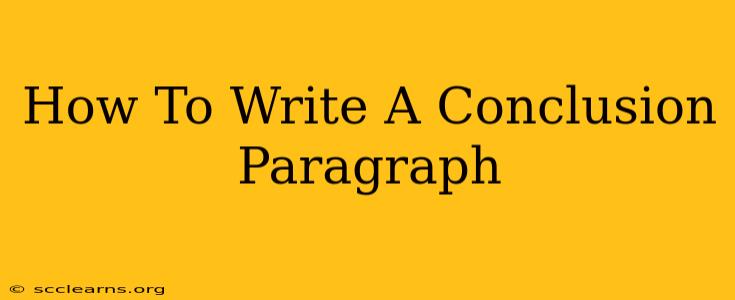Writing a compelling conclusion paragraph is crucial for any piece of writing, be it an essay, research paper, or even a short story. It's your final opportunity to leave a lasting impression on your reader, solidifying your points and leaving them with something to think about. A weak conclusion can undermine even the strongest introduction and body paragraphs. This guide will provide you with the essential steps to craft a conclusion that truly shines.
Understanding the Purpose of a Conclusion Paragraph
Before diving into the "how-to," let's clarify the why. The conclusion paragraph serves several vital purposes:
- Summarizing Main Points: It briefly restates the key arguments or findings presented in your work. Think of it as a concise recap, highlighting the most important takeaways.
- Offering a Synthesis: It doesn't simply reiterate; it synthesizes the information, showing how the different parts of your work connect and support your overall thesis.
- Providing Closure: It brings the piece to a satisfying end, leaving the reader with a sense of completion and understanding.
- Leaving a Lasting Impression: This is the opportunity to make your work memorable, prompting further thought or action.
Steps to Write a Powerful Conclusion Paragraph
Crafting an effective conclusion requires a strategic approach. Follow these steps for a polished and impactful result:
1. Restate Your Thesis (But Don't Just Repeat It!)
Your conclusion should echo your thesis statement, but avoid simply copying and pasting it. Instead, rephrase it in a way that reflects the insights and evidence you've presented. This demonstrates a clear understanding of your argument and its development throughout the piece.
2. Summarize Your Main Points Concisely
Briefly summarize the key supporting points you made in your body paragraphs. Focus on the most important arguments and evidence, omitting unnecessary details. This reinforces the core message of your writing.
3. Offer a Synthesis: Connect the Dots
Go beyond simply listing your points. Explain how they relate to each other and contribute to your overall thesis. Show the reader the bigger picture, demonstrating the interconnectedness of your arguments.
4. Provide Insightful Concluding Remarks
This is where you leave your mark. Consider these options:
- Offer a prediction or projection based on your findings.
- Pose a thought-provoking question to encourage further reflection.
- Suggest implications or applications of your work.
- End with a memorable quote or anecdote that reinforces your main point.
- Call to action (if appropriate): Encourage readers to take a specific action based on your insights.
5. Maintain a Consistent Tone and Style
Keep the tone and style consistent with the rest of your writing. Avoid introducing new information or abruptly shifting your perspective. A seamless transition from the body to the conclusion is crucial.
6. Proofread Carefully
As with any part of your writing, meticulously proofread your conclusion for grammatical errors, typos, and clarity issues. A polished conclusion reflects professionalism and attention to detail.
Examples of Effective Conclusion Paragraphs:
Let's look at a few examples to illustrate the concepts discussed above. Imagine you've written an essay arguing for stricter environmental regulations. A weak conclusion might simply restate the argument without adding anything new. A strong conclusion would synthesize the arguments, perhaps by projecting the potential benefits of stricter regulations or posing a thought-provoking question about the future of environmental responsibility.
Common Mistakes to Avoid
- Introducing new information: Avoid presenting new arguments or evidence in your conclusion.
- Being overly apologetic or unsure: Stand by your arguments.
- Using clichés or overly general statements: Strive for originality and precision.
- Ending abruptly without a clear sense of closure: Provide a satisfying conclusion to your writing.
By following these steps and avoiding common pitfalls, you can craft a conclusion paragraph that leaves a truly lasting impression on your readers, enhancing the overall impact of your work. Remember, the conclusion is your final opportunity to shine!

